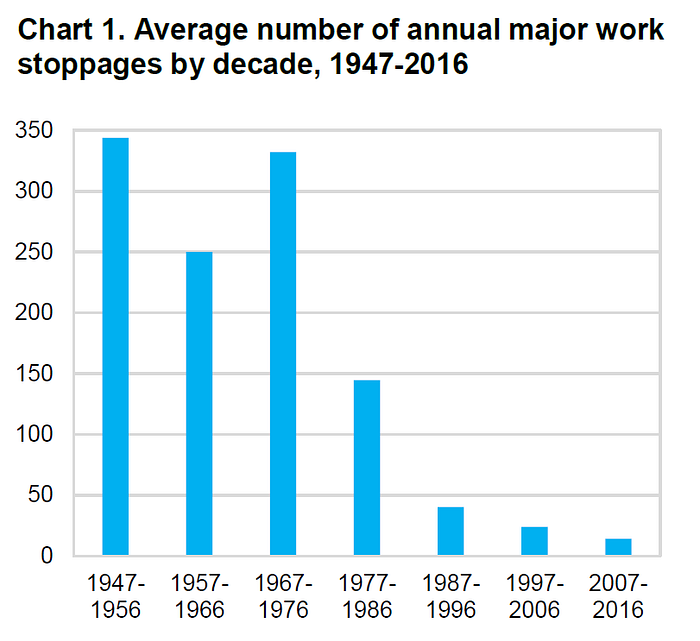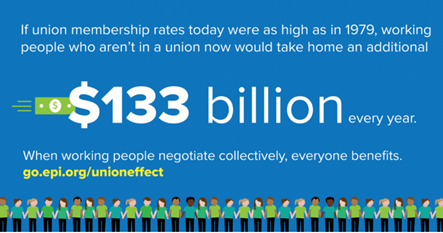Strike Out: The Number of Large Strikes Continues to Decline
The Bureau of Labor Statistics recently released its data for major work stoppages in 2016. These are defined as:
The term “major work stoppage” includes both worker-initiated strikes and employer-initiated lockouts that involve 1,000 workers or more and lasting at least one shift.
For those who follow trends in the labor movement, we expect these days to see low numbers of large strikes and last year was no exception — there were only 15 major work stoppages, involving 99,000 workers. Though this data includes both strikes (the workers stop working) and lockouts (the employer stops the workers from working), the vast majority of these events are typically strikes. The BLS notes the long term trend, and shows the average for each decade over time:
This year marks 70 years of work stoppages data collected by the U.S. Bureau of Labor Statistics. Over the past four decades (1977–1986 to 2007–2016) major work stoppages declined approximately 90 percent…The period from 2007 to 2016 was the lowest decade on record, averaging approximately 14 major work stoppages per year. The lowest annual number of major work stoppages was 5 in 2009.

This is simply an astonishing decline. The year with the largest number of recorded large work stoppages was 1952 with 470, over 30 times the 2016 number. This was also the year with the largest number of workers involved at over 2.7 million workers, about 28 times the 2016 number. Most significantly for economic impact, the BLS also tracks total days idle and the percentage of all work days that were idle that year. The year with the largest number of idle days was 1959 with almost 61 million days, accounting for 0.43% of all work time. This was the year of the massive Steelworkers strike, one of the largest strikes in U.S. history, involving 500,000 workers out for 116 days. Jack Metzger’s Striking Steel discusses that historic strike.
Are Strikes Actually Declining?
It’s important to note that this data covers large strikes of at least 1,000 workers. What about smaller strikes? Is it possible that strike activity is not really declining but for some reason, more strikes over time occur at smaller workplaces and are thus not counted? For example, if workplaces are getting smaller over time, then strike activity will tend to disappear in the official data. It would be interesting to look at a more complete picture of strike activity, but for now, I’m fairly confident that the apparent decline in strike activity in this data is representative of strikes overall. I’m sure most members and observers of the labor movement would agree that strike activity has in fact been declining.
Why Are Strikes Declining?
First we must recognize that strikes are hard to win. It is legal to permanently replace strikers fighting for a better contract, so workers risk losing their jobs. For Unfair Labor Practice strikes, where workers are protesting specific illegal employer actions, workers can be replaced for the duration of the strike. This makes it difficult to shut down production. If the employer can run their operations at some level with managers and scabs, workers may be out on strike for months or sometimes years, all without their wages and benefits. Simply put, often the employer can outlast the workers.
The ban on “secondary” strikes plays a role here too and it is difficult to legally spread a strike to other companies in ways that would help the workers. For example, let’s say there is a strike at a company that makes a product which is sold at another company’s store. It would not be legal for the striking workers to picket the store or ask the store workers to strike or refuse to handle that struck product and those store workers would not have any legal protections if they chose to do so.
It is also illegal for federal workers and many state level public sector workers to strike and they risk being fired. A famous example is the PATCO air traffic controller strike in 1981 when President Reagan fired over 11,000 workers. This and many other high profile large strikes that ended badly for workers have led to the general understanding that large strikes probably can’t be won. In the 1980’s this was referred to as the “PATCO Syndrome.”
This explains why strikes are hard to win but not why they are declining. In fact, strikes have never been easy to win. Other causes matter as well. I think a major factor is that strikes were a much more central part of building the labor movement in the 1930’s and 1940’s and that practice carried over into later decades. Eventually as unions became more institutionalized and collective bargaining became more routine, strikes were seen by union leaders as unnecessary and something to avoid. Over time as employers fought strikes even harder, unions’ fear of losing strikes increased. And with increasing globalization, automation and outsourcing, it may seem that leverage and power has shifted to employers.
We can add the Left critique to this which maintains that the government-administered union election and collective bargaining process has achieved what the government wanted — to domesticate the labor movement and discourage strikes. After all, the official rationale for the National Labor Relations Act of 1935 was to allow workers to bargain collectively in order to maintain the free flow of commerce, in other words, to eliminate strikes:
It is declared to be the policy of the United States to eliminate the causes of certain substantial obstructions to the free flow of commerce and to mitigate and eliminate these obstructions when they have occurred by encouraging the practice and procedure of collective bargaining and by protecting the exercise by workers of full freedom of association, self- organization, and designation of representatives of their own choosing, for the purpose of negotiating the terms and conditions of their employment or other mutual aid or protection.
In Staughton Lynd’s book We Are All Leaders: The Alternative Unionism of the Early 1930’s, there is a fascinating example in the chapter on the massive Textile Workers Strike of 1934 which illustrates union leaders’ attitude towards strikes even at that early date. Largely on their own initiative, nearly 400,000 workers struck, including 170,000 in the south. The major issue was the “stretch-out”, where the employer would pile on more work for each worker. Rather than fully support this strike, the leaders of the United Textile Workers settled the conflict for more influence on the government industry policy board that was set up at the time, an entity that repeatedly failed to address workers concerns.
To be sure, in the years following the 1934 defeat organized labor strengthened its role in government oversight of labor relations, but the scope of government oversight was now limited to those areas outlined after the 1934 strike was over. Unions were now tied to an agenda set by the federal government rather than by their own membership. What the government determined to be legitimate grievances the union could fight for; what government policy ignored were inadmissible grievances. Crucial areas of union autonomy no longer existed.
This “seat at the table” approach has been a key goal for labor ever since, and more so as strikes appear to be unwinnable. This strategy necessarily comes at the expense of rank and file militancy. Now we have a labor movement culture no longer steeped in strike activity and my guess is that most union members today have never been on strike.
Should There be More Strikes?
Right-wingers are no fans of strikes since many don’t approve of workers taking collective action at all. Centrists would prefer that workplace differences be resolved through negotiations and without strikes. This is certainly how the mainstream media generally cover strikes and of course the government also takes this position.
But even many on the left who support workers on strike may regard strikes as a tragic occurrence and a necessary evil, best avoided if possible. However we need to remember that the collective withholding of labor is crucial in the ongoing contest between labor and capital. Employers as a group need to see that power regularly in order to deter their constant demands for concessions and lower labor costs. And workers gain much needed organizing experience using this collective power and inspire other workers to take action as well. Large strikes can also highlight important issues of public concern. The victorious Teamsters strike of 185,000 UPS workers in 1997 addressed the growing problems of part-time work. The successful Chicago Teachers Union strike of 30,000 teachers in 2012 fought for a progressive education agenda.
Strikes certainly bring hardships to individual workers and that’s why we need much greater solidarity efforts to assist strikers with funds, food and other necessities. Of course strikes also bring inconvenience to consumers, after all this is economic disruption, but we should make more and better efforts to explain the need for these actions, not just to defend the workers involved, but as part of labor’s overall efforts to raise standards for everyone. The Economic Policy Institute reports that the decline of unions has cost non-union workers $133 billion in annual wages because standards have dropped for everyone. As a collective show of strength, many more strikes should be encouraged and celebrated rather than avoided and regretted.

Now some could say that maybe strikes aren’t necessary. After all, since workers have the right to collective bargaining, perhaps they get what they need without striking. Even if this were true for many individual contract negotiations, and that can be debated, the decline of strikes has matched the decline of union membership and density (the percentage of all workers who are union members) and has thus led to an overall loss of strength for labor. This inevitably leads over time to worse outcomes at the bargaining table. In a previous post I discuss this decades-long decline.
It’s just no coincidence that labor movement membership has been declining along with the use of strikes. They are that important. The reduced number of strikes over time has contributed to the decline of the labor movement, and that decline has in turn weakened labor’s ability to successfully strike. Any reversal of this trend as part of the rebuilding of the labor movement must include building up the capacity to strike and win regularly.
